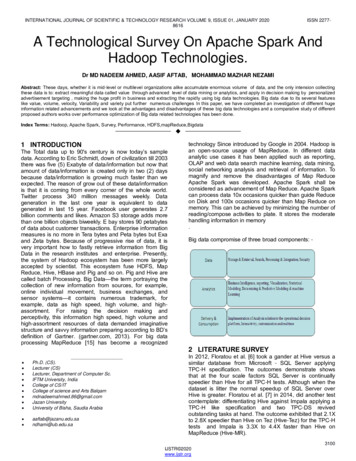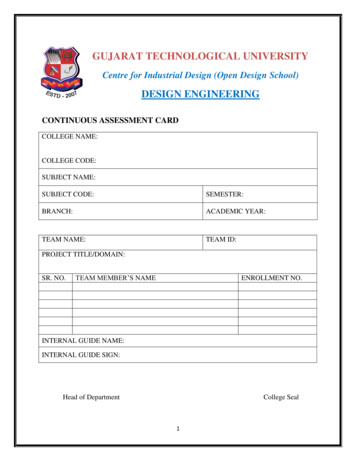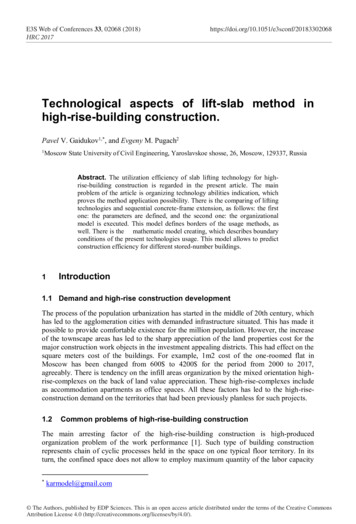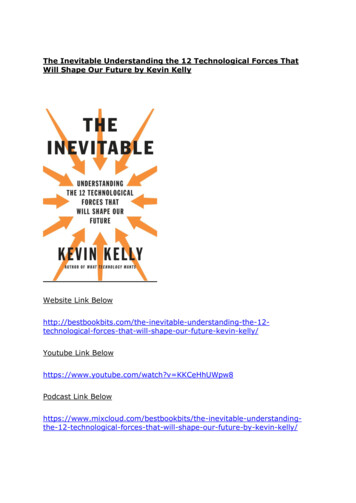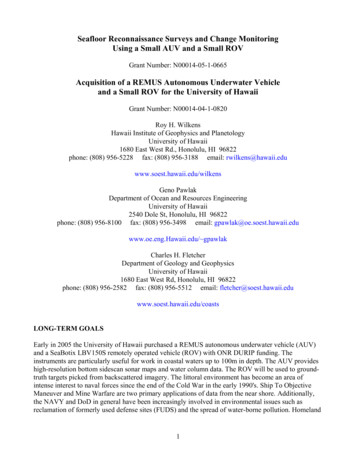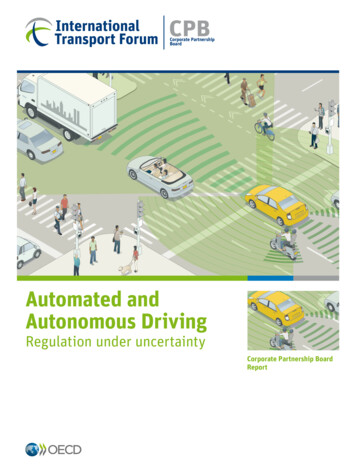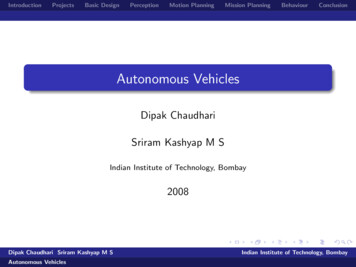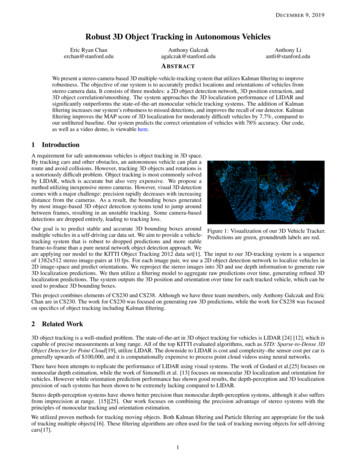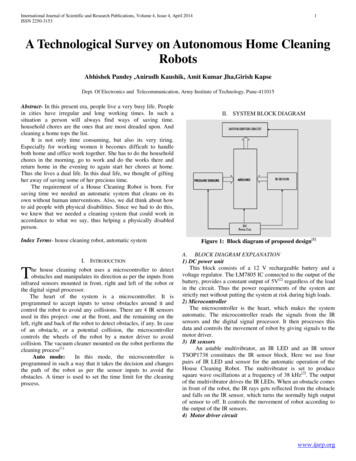
Transcription
International Journal of Scientific and Research Publications, Volume 4, Issue 4, April 2014ISSN 2250-31531A Technological Survey on Autonomous Home CleaningRobotsAbhishek Pandey ,Anirudh Kaushik, Amit Kumar Jha,Girish KapseDept. Of Electronics and Telecommunication, Army Institute of Technology, Pune-411015Abstract- In this present era, people live a very busy life. Peoplein cities have irregular and long working times. In such asituation a person will always find ways of saving time.household chores are the ones that are most dreaded upon. Andcleaning a home tops the list.It is not only time consuming, but also its very tiring.Especially for working women it becomes difficult to handleboth home and office work together. She has to do the householdchores in the morning, go to work and do the works there andreturn home in the evening to again start her chores at home.Thus she lives a dual life. In this dual life, we thought of giftingher away of saving some of her precious time.The requirement of a House Cleaning Robot is born. Forsaving time we needed an automatic system that cleans on itsown without human interventions. Also, we did think about howto aid people with physical disabilities. Since we had to do this,we knew that we needed a cleaning system that could work inaccordance to what we say, thus helping a physically disabledperson.Index Terms- house cleaning robot, automatic systemI. INTRODUCTIONThe house cleaning robot uses a microcontroller to detectobstacles and manipulates its direction as per the inputs frominfrared sensors mounted in front, right and left of the robot orthe digital signal processor.The heart of the system is a microcontroller. It isprogrammed to accept inputs to sense obstacles around it andcontrol the robot to avoid any collisions. There are 4 IR sensorsused in this project- one at the front, and the remaining on theleft, right and back of the robot to detect obstacles, if any. In caseof an obstacle, or a potential collision, the microcontrollercontrols the wheels of the robot by a motor driver to avoidcollision. The vacuum cleaner mounted on the robot performs thecleaning process[1].Auto mode:In this mode, the microcontroller isprogrammed in such a way that it takes the decision and changesthe path of the robot as per the sensor inputs to avoid theobstacles. A timer is used to set the time limit for the cleaningprocess.II. SYSTEM BLOCK DIAGRAMFigure 1: Block diagram of proposed design[1]A. BLOCK DIAGRAM EXPLANATION1) DC power unitThis block consists of a 12 V rechargeable battery and avoltage regulator. The LM7805 IC connected to the output of thebattery, provides a constant output of 5V[2] regardless of the loadin the circuit. Thus the power requirements of the system arestrictly met without putting the system at risk during high loads.2) MicrocontrollerThe microcontroller is the heart, which makes the systemautomatic. The microcontroller reads the signals from the IRsensors and the digital signal processor. It then processes thisdata and controls the movement of robot by giving signals to themotor driver.3) IR sensorsAn astable multivibrator, an IR LED and an IR sensorTSOP1738 constitutes the IR sensor block. Here we use fourpairs of IR LED and sensor for the automatic operation of theHouse Cleaning Robot. The multivibrator is set to producesquare wave oscillations at a frequency of 38 kHz[2]. The outputof the multivibrator drives the IR LEDs. When an obstacle comesin front of the robot, the IR rays gets reflected from the obstacleand falls on the IR sensor, which turns the normally high outputof sensor to off. It controls the movement of robot according tothe output of the IR sensors.4) Motor driver circuitwww.ijsrp.org
International Journal of Scientific and Research Publications, Volume 4, Issue 4, April 2014ISSN 2250-3153A motor driver is used to control the two geared DC motors.It can make a motor rotate in either clockwise direction or inanti-clockwise direction according to the control inputs given toit. The microcontroller provides the control signals to the motordriver IC according to the output of DSP in manual mode or IRsensors in automatic mode.III. FLOWCHARTFigure 2: Flowchart defining steps of the dataflow2IV. TECHNOLOGICAL PRODUCT SURVEYA. DESCRIPTIONAll Roomba models are disc-shaped, 34 cm (13") indiameter and less than 9 cm (3.5") high. A large contact-sensingmechanical bumper is mounted on the front half of the unit, withan omnidirectional infrared sensor at its top front center. Arecessed carrying handle is fitted on the top of most units.As of 2012, there have been four generations of Roombaunits: the first-generation original models, the second-generation"Discovery" series, the third-generation 500 series and thefourth-generation 600/700 series. All utilize a pair of brushes,rotating in opposite directions, to pick up debris from the floor.In most models, the brushes are then followed bya squeegee vacuum, which directs the airflow through a narrowslit to increase its velocity in order to collect fine dust. Ahorizontally mounted "side spinner" brush on the right side of theunit sweeps against walls to reach debris not accessible by themain brushes and vacuum. In the first generation of robots, thedirty air passes through the fan before reaching the filter, whilelater models use a fan-bypass vacuum.The Roomba is powered by removable nickel-metalhydride batteries (NiMH), which must be recharged regularlyfrom a wall power adapter. Newer second and third generationmodels have a self-charging homebase which they automaticallytry to find at the end of cleaning session via infrared beacons.Charging on the homebase takes about three hours.Four infrared "cliff sensors" on the bottom of the Roombaprevent it from falling off ledges such as the top steps ofstairways. Most second- and third-generation models haveinternal acoustic-based dirt sensors (The Dirt Detect Series 1Technology) that allow them to detect particularly dirty spots(zones having excess particulates) and focus on those areasaccordingly. Fourth generation models have an optical sensorlocated in front of the vacuum bin (The Dirt Detect Series 2Technology) allowing Roomba to detect wider and smallermesses. Many second and third generation Roombas comepackaged with IR (infrared) remote controls, allowing a humanoperator to "drive" the robot to areas to be specially cleaned.B. OPERATIONAll Roomba models can be operated by manually carryingthem to the room to be cleaned and pressing the appropriatebutton. Later models introduced several new operating modes."Clean" mode is the normal cleaning program, starting in a spiraland then following a wall, until the room is determined to beclean. "Spot" mode cleans a small area, using an outward-theninward spiral. "Max" runs the standard cleaning algorithm untilthe battery is depleted. "Dock" mode, introduced with the thirdgeneration, instructs the robot to seek a self-charging homebasefor recharging. The availability of the modes varies depending onmodel, generally with higher-end units having more features.The robot's bumper prevents them from bumping into wallsand furniture by reversing or changing path accordingly. Thethird- and fourth-generations, which move faster than previousmodels, have additional forward-looking infrared sensors in itsbumper to detect obstacles. These slow down when nearingobstacles to reduce its force of impact (Light TouchTechnology). Additionally, this technology is able to distinguishbetween soft and solid barriers. After a sufficient period of timewww.ijsrp.org
International Journal of Scientific and Research Publications, Volume 4, Issue 4, April 2014ISSN 2250-3153cleaning, the Roomba will either search for and dock with thehomebase, or stop where it is.The cleaning time depends on room size and, for newermodels equipped with acoustic dirt sensors, volume of dirt. Firstgeneration models must be told the room size, while second- andthird-generation models estimate room size by measuring thelongest straight-line run they can perform without bumping intoan object. When finished cleaning, or when the battery is nearlydepleted, a second- or third-generation Roomba will try to returnto a homebase if one is detected. A second-generation Roombamay also be used with the external Scheduler accessory, allowingcleaning to start automatically at the time of day and on days ofthe week that the owner desires. Most 500 Series robots supportscheduling through buttons on the unit itself, and higher-endmodels allow the use of a RF remote to program schedules.Unlikethe ElectroluxTrilobite vacuumingrobots,Roombas do not map out the rooms they are cleaning. Instead,iRobot developed a technology called iAdapt ple algorithms such as spiral cleaning (spiralling), roomcrossing, wall-following and random walk angle-changing afterbumping into an object or wall. This design is basedon MIT researcher and iRobot CTO Rodney Brooks' philosophythat robots should be like insects, equipped with simple controlmechanisms tuned to their environments. The result is thatalthough Roombas are effective at cleaning rooms, they takeseveral times as long to do the job as a person would. TheRoomba may cover some areas many times, and other areas onlyonce or twice. The Virtual Wall accessories project infraredlight beams which the Roomba will not cross. Newer modelScheduler Virtual Walls can be set up to turn on via IR at thesame time a Roomba is activated. As Virtual Walls are batterypowered, this is desirable to avoid wasting power projecting IRbeams when not needed.The Roomba is not designed for deep-pile carpet. Also, thefirst- and second-generation Roombas can get stuck on rugtassels and electrical cords. The third-generation is able toreverse its brushes to escape entangled cords and tassels.Additionally, all models are designed to be low enough to gounder a bed or most other items of furniture. If at any time theunit senses that it has become stuck, no longer senses the floorbeneath it, or it decides that it has worked its way into a narrowarea from which it is unable to escape, it stops and sounds anerror to help its owner find it. Early models use only flashinglights to indicate specific problems, while later models use voicesynthesis to announce a problem and a suggested solution.General maintenance of the Roomba consists of emptyingthe debris bin and cleaning the dust filter, as well as removingand cleaning the brushes. Excessive hair accumulation in thebrush system can cause the brushes to stall, or overload the brushmotor, damaging the unit. Lesser amounts of hair build-up willmerely slow down the brushes, reducing cleaning effectivenessand battery life. Special "pet-friendly" options and models areavailable, which are supposed to be more resistant to hair buildup, and easier to clean.C. BATTERY-LIFE AND RELIABILITYBattery reliability is a frequently-mentioned complaint onthe iRobot, Amazon, and other third-party customer review3websites. Battery replacements from iRobot cost a significantfraction of the purchase price of a new Roomba, thoughcompatible third-party batteries are available at a lower price.The iRobot customer support website offers advice onmaximizing battery performance and longevity. All batteries willgradually lose energy capacity, resulting in shorter cleaning runs,eventually necessitating replacement. Roomba batteries are enduser replaceable within minutes.When a Roomba owner is absent for an extended period(such as a vacation or due to illness), automatically scheduledcleaning runs should be cancelled. For example, if it becomesentangled and stops with an error sound on an unattendedsession, the battery will remain deeply discharged for anextended period, often resulting in permanent damage to thebattery.D. ACCESSORIES1) Easy Clean Brush — A brush that is designedspecifically for cleaning pet hair, being easier to cleanoff (standard on models designated "for pets").2) Remote Control — Allows the owner to remotelyoperate basic Roomba functions (works with all secondand third-generation Roombas).3) Wireless Command Center — Allows the owner toremotely operate most Roomba functions, includingscheduling (works only with certain third-generationRoombas).4) iRobot Scheduler — Allows the owner to program theRoomba to clean at certain times automatically. The"Schedule Upgrade" accessory will also update a pre2.1 Roomba to the 2.1 software (for second-generationRoombas).5) Homebase — The Roomba automatically returns to anddocks here for recharging (for second- and thirdgeneration Roombas).6) Virtual Wall — Used for keeping the Roomba out ofdesignated areas.7) Virtual Wall Lighthouse — Functionality of VirtualWall with an additional "Lighthouse" mode, which willcontain Roomba in one room until the room iscompletely vacuumed before moving on to the next. Asof 2012, iRobot has sold at least 5 different Virtual Walldesigns, with different cases and capabilities.8) Virtual Wall Halo — Designates a circular zone 20"(50 cm) in diameter to protect small items, like petwater and feeding bowls, from being disturbed by aRoomba9) OSMO — A temporary dongle that attaches to the serialport on the Roomba to update a pre-2.1 Roomba'sfirmware to version 2.1; this also can correct the "circledance" problem (for all second-generation Roombas).10) Advanced Power System (APS) Battery — Higherperformance rechargeable battery for all models thatholds enough power to clean for 200 minutes.11) Roomba Serial Control Interface (Roomba SCI) —Exposes all the functionalities and sensor informationfrom the iRobot Roomba vacuum cleaner for externalinterfacing. Using the SCI, aroboticist can commandwww.ijsrp.org
International Journal of Scientific and Research Publications, Volume 4, Issue 4, April 2014ISSN 2250-31534and control the Roomba by connecting to the 7-pinMini-Din UART port.12) Roo series of accessories, by RoboDynamicsa. RooTooth — A Bl
A Technological Survey on Autonomous Home Cleaning Robots Abhishek Pandey ,Anirudh Kaushik, Amit Kumar Jha,Girish Kapse Dept. Of Electronics and Telecommunication, Army Institute of Technology, Pune-411015 Abstract- In this present era, people live a very busy life. People in cities have irregular and long working times. In such a
